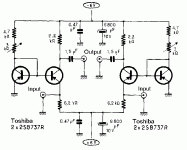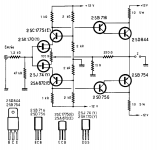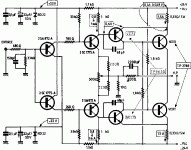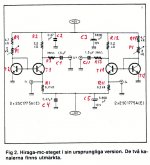Never found an input transformer that I really like. That is why I started with learning how to design ultra low noise bipolar and fet devices about 50 years ago, in order to get rid of the Ortofon input transformer. That is where the SCP-1 came from, McKinnie is derived from the Vendetta SCP-1, because I gave the schematic to my former Swiss trained technician, Reza O., to build, hoping for some royalties.
Zung, the circuit should be like this (with mods by Reza):
Zung, the circuit should be like this (with mods by Reza):
Attachments
Last edited:
I need to dig deep now to find the plots , but a few years ago i really found a Lundahl transformer for mc carts that was measured against a very famous mc dicrete preamp showing to be more linear and lower noise than the solid state counterpart...
Last edited:
... McKinnie is derived from the Vendetta SCP-1, because I gave the schematic to my former Swiss trained technician, Reza O., to build, hoping for some royalties.
Zung, the circuit should be like this (with mods by Reza):
Thanks!
I do hope you got some royalties out of it. There's one currently on eBay, the asking price is £2,400!
I don't believe we will never reach neutrality as long as we will use our actual speakers. Most of the modern amps are near perfect, on the paper or the oscilloscope. It is the way they drive the speaker that makes a change, omho. All the speakers and all the rest of the system to a lesser extent, have they own passport. It is about, how to say, trying to compensate losses of some gears by the excess of some others and the contrary. An overshoot with a slower device. As say Richard, measuring the distortion or the noise of a single part of a system is not so interesting. It is the assembly that matters, don't you think ?As usual it depends on the specifics; if "voicing a gear" means to meet a specific sound target (that is diverging from being neutral/transparent) then it is a different situation compared to trying for reaching neutrality/transparency.
Voicing a system is (for me) trying to find the best compromise between a highly detailed system (my actual one), which comes often with fatigue and pushes forward the defects of the sources (bad mixs), and a system that comes with an agreeable own character that can sand those defects. Some ones love tubes for this. It will never be perfect, but everything is in the quest ?
On my book, it is obvious when I can hear differences at each comparison, in a repeated way, without too much concentration. If not, I don't care so much, because when it is at the limit pf audibility with instant comparison, what to fear about long term memory, or our mood changes. See what I mean ?The differences we are talking about in these threads are often described as "obvious" ...
This said, it do not replace long time listening, an other way with other results.
The problem is, while I'm my own expert ;-), i don't trust too much in myself.But in any case it is additionally a matter of trust; quite frequently other fields - using sensory tests - an expert is asked and if this experts says the different is really small then the more sophisticated controlled sensory tests come into play.
A lesson that life had gave to me, that do not make the life easier.
Mexican boots and guitar straps ?There's a little boots and braces in all of us (except maybe Mr. Marsh).
Dreamth, i have 2 transformers in front of me that I auditioned a couple of years ago from Lundahl: LL1931 Amorphous core, and LL1933 MuMetal core. Both for MC.
One, measured lousy at low frequencies (Amorphous)
Two, did not sound as good in the midrange, according to the manufacturer.
I gave up on both, but they are both good transformers, just limited to the technology of today. No, I will stick to direct solid state input that works for me.
One, measured lousy at low frequencies (Amorphous)
Two, did not sound as good in the midrange, according to the manufacturer.
I gave up on both, but they are both good transformers, just limited to the technology of today. No, I will stick to direct solid state input that works for me.
I started with learning how to design ultra low noise bipolar and fet devices about 50 years ago, in order to get rid of the Ortofon input transformer.
An externally hosted image should be here but it was not working when we last tested it.
This guy did the same at the same time with you in Europe...It seems that he was a bit more successful in getting to the essence of an audio amplifier, as you can easily find low noise pnp tansistors which are also lower noise than their fet counterparts when driven by low source impedance...
So he used 4 pnp transistors for both channels...If there's any significant DA due to the output capacitors, than maybe it's welcome to reduce high freq resonances in mc cartridges 🙂
An externally hosted image should be here but it was not working when we last tested it.
He started as you with complementary input fets, but he was quicker at realizing that you can get the essence in a much simpler way:
An externally hosted image should be here but it was not working when we last tested it.
I think that there's no simpler design ever made for the purpose and there are more clones of his designs than any other class A designs for a reason even though it's quite an expensive amp to manufacture due to large heatsink needed and capacitors to compensate for the large currents and poor PSRR.
Nothing is for free in this world, but i can build a Hiraga anytime with available components.
As you can easily see, his design don't need any zobel network or inductors at the output either as no class A amp ever needed such things being inherently stable with minimum gain.
And it's current feedback too!
As this is a super sized version of Hiraga made later in the diy world, and the only version of Hiraha i ever listened to, i can surely tell that this is a hell of an amp and it sounds indeed very well.
An externally hosted image should be here but it was not working when we last tested it.
Attachments
Last edited:
I'll try find the mesurements done by an independent guy for that transformer that i can't remember of right now and come back with some graphs and names.Dreamth, i have 2 transformers in front of me that I auditioned a couple of years ago from Lundahl: LL1931 Amorphous core, and LL1933 MuMetal core. Both for MC.
One, measured lousy at low frequencies (Amorphous)
Two, did not sound as good in the midrange, according to the manufacturer.
I gave up on both, but they are both good transformers, just limited to the technology of today. No, I will stick to direct solid state input that works for me.
I stayed at home for an entire period of 2.5 years doing nothing else, but phono preamps reading all the literature available on the internet until 2 years ago, including your designs.
That time simply drained all my financial resources, but i knew that i wanted to know everything about this world.
The best diy designs are still transformer coupled valve designs in both small signal and large signal amplification.
In Japan nobody gives a damn thing on developing solid state audio anymore for almost 10 years.All you see, including Accuphase designs are done up until 20 years ago.
Last edited:
"Every trim pot shows the designer's incompetence." (My diploma thesis supervisor)
Good circuits must be predictable and they must work perfectly
with the pre-computed parameters.
It seems it is only high end audio where tinkering with arrays
of loose contacts made from coal or cermet is acceptable.
The previous posts contain lots of them.
Good circuits must be predictable and they must work perfectly
with the pre-computed parameters.
It seems it is only high end audio where tinkering with arrays
of loose contacts made from coal or cermet is acceptable.
The previous posts contain lots of them.
Last edited:
"Every trim pot shows your incompetence." (My diploma thesis supervisor)
Crap! I'm old enough to actually have sat in a classroom with R. D. Thornton who IIRC actually patented trimming an LTP for drift and offset.
Last edited:
"Every trim pot shows your incompetence." (My diploma thesis supervisor)
Good circuits must be predictable and they must work perfectly
with the pre-computed parameters.
It seems it is only high end audio where tinkering with arrays
of loose contacts made from coal or cermet seem acceptable.
The previous posts contain lots of them.
...that happened to be launched more than 40 years ago when only lm344(194) was...OR NOT??? available and it wasn't as low noise as the lowest noise bipolars, but...
What a coincidence THAT bipolar transistors made their way t-t-t-to our world!
THAT Corporation 300-series Low-Noise Matched Transistor Array ICs
An externally hosted image should be here but it was not working when we last tested it.
The NPN version of it!!!
An externally hosted image should be here but it was not working when we last tested it.
Attachments
Last edited:
And the Hiraga pre pre can be used also in balanced configuration which will improve the common mode and will remove entirely the output capacitors so that JC can smile too 🙂 You could thus use a single supply for even greater PSRR.
Last edited:
Now that's an excellent example. It seems, Hiraga wasn't even sure about the
optimum current for his current mirrors. If it was only for enforcing
symmetry, 1 would have been enough. He could also have degenerated
the mirrors when the transistors are way to different. There ARE ways to make
things predictable.
And, Scott, you should know better. There is no trim pot set for the 797, so you
seem to have managed not to postpone the definition of the operating points.
I don't mind a zero cal point in a precision dc amplifier.
I doubt there are trim pots in the engine controller of my BMW. When I brought
it to the TÜV last time (legally required bi-annual check out) the idle RPM to be
expected was 600 (allowed 500-700) and it was 600. Exactly. Probably that was a
comparison between their crystal and mine. 🙂
I have never ever deployed a trim thing in any of our ultrasonics machines to
find cracks in the inner enclosure of nuclear reactors and I have never even
asked if there are space qualified trim pots. Not even trim caps for the
crystal oscillators. The customer would have been ROTFL. The XOs are locked to
the Hydogen Maser or Cs. Exactly. There is no trim thing in the entire payload.
optimum current for his current mirrors. If it was only for enforcing
symmetry, 1 would have been enough. He could also have degenerated
the mirrors when the transistors are way to different. There ARE ways to make
things predictable.
And, Scott, you should know better. There is no trim pot set for the 797, so you
seem to have managed not to postpone the definition of the operating points.
I don't mind a zero cal point in a precision dc amplifier.
I doubt there are trim pots in the engine controller of my BMW. When I brought
it to the TÜV last time (legally required bi-annual check out) the idle RPM to be
expected was 600 (allowed 500-700) and it was 600. Exactly. Probably that was a
comparison between their crystal and mine. 🙂
I have never ever deployed a trim thing in any of our ultrasonics machines to
find cracks in the inner enclosure of nuclear reactors and I have never even
asked if there are space qualified trim pots. Not even trim caps for the
crystal oscillators. The customer would have been ROTFL. The XOs are locked to
the Hydogen Maser or Cs. Exactly. There is no trim thing in the entire payload.
There's a little boots and braces in all of us (except maybe Mr. Marsh).
😕
No. It was the same for me as well.
- Mr Marsh
🙂
Dreamth, give it a break, I was working with single ended low noise devices since 1968. In 1978, I was introduced to Hitachi to get their complementary ultra low noise devices. I first met Jean Hiraga in 1978 as well, and even bought one of his cute phono stages that ran on batteries (kind of a bird cage construction). He has been very helpful with his overall ideas on audio design, but he knows about as much about real circuit design as you do, Dreamth, and that is limited.
I've heard about instant switching but instant comparison?If not, I don't care so much, because when it is at the limit pf audibility with instant comparison, what to fear about long term memory, or our mood changes. See what I mean ?

Long time listening is plagued by your so called fatigue / stress.This said, it do not replace long time listening, an other way with other results.

...that happened to be launched more than 40 years ago when only lm344(194) was...OR NOT??? available and it wasn't as low noise as the lowest noise bipolars, but...
What a coincidence THAT bipolar transistors made their way t-t-t-to our world!.....
Yes, in our case that was MAT -01 -02 -03 -04, whatever.
I have even used a few in a low noise preamp. That high-price stuff
can survive dozens of years in the drawer ( see the date codes printed on them)
< Album Archive >
Last edited:
At least i know that about me...He has been very helpful with his overall ideas on audio design, but he knows about as much about real circuit design as you do, Dreamth, and that is limited.
Last edited:
And, Scott, you should know better. There is no trim pot set for the 797, so you
seem to have managed not to postpone the definition of the operating points.
I don't mind a zero cal point in a precision dc amplifier.
It's known as laser trimming of thin film, maybe we are not talking about the same thing??? I've worked with dozens of auto module makers thick film trimming was the norm to tune all the modules to nominal specs. Trim does not equal pots.
Last edited:
- Status
- Not open for further replies.
- Home
- Member Areas
- The Lounge
- John Curl's Blowtorch preamplifier part III




